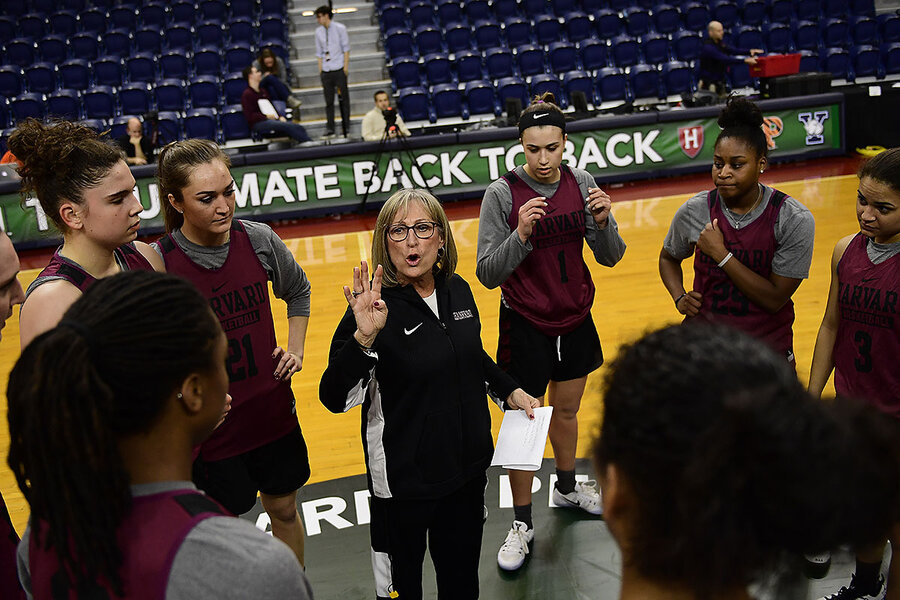Why there's been a big drop in women coaches under Title IX
Loading...
| Cambridge, Mass.
As a synchronized swimmer in college, Kathy Delaney-Smith did not seem destined to become Harvard’s star women’s basketball coach.
When she interviewed for a swim coach position in Boston’s southwestern suburbs back in the early 1970s, the superintendent asked if she could also coach their basketball team. “And I'm like, ‘Yes, of course I can,’ ” she recalls, despite having only played on an informal team – coached by her mom – where the girls played six-on-six and didn’t even dribble. “I don’t know where that came from.… I didn’t know anything about anything, but I really wanted the job.”
The first year, her basketball squad went 0-11.
So she read books, went to clinics, and built a team that went undefeated for six seasons. That brought a Harvard recruiter to her door. Since saying yes 35 years ago, she has become the winningest head coach in Ivy League history, with 567 career wins and 330 Ivy League victories. That’s more than any other coach – men’s or women’s – in the entire Ivy League.
Now Delaney-Smith is on the forefront of a different challenge, one in some ways brought on by the success of women’s sports. The ranks of female collegiate athletes have grown sixfold since Title IX, the 1972 law promoting gender equality in education. But paradoxically, as women’s sports became more competitive, the percentage of teams coached by women has dropped from 90 percent to less than half.
“You see this everywhere in the economy, 80 percent of leadership positions go to men,” says David Berri, co-author of “The Wages of Wins: Taking Measure of the Many Myths in Modern Sport.” “[Recruiters] interview people, but in the end, they settle on what they had before and what they feel comfortable with.”
Correcting that imbalance is proving difficult, in part because the dearth of women coaches discourages others from joining their ranks. But Delaney-Smith and others are working to address the factors that have caused the decline, from gender bias in hiring to lack of professional development opportunities to an increasingly demanding competition and travel schedule that interferes with work-life balance for those with young children.
If successful, their efforts could not only encourage and empower more women to join the leadership ranks of collegiate athletics, but also have a snowball effect by inspiring others to follow suit.
“We know from the data that girls and women coached by women are more likely to go into coaching,” says Nicole LaVoi, co-director of Tucker Center for Research on Girls and Women in Sport in Minneapolis. “If we don’t have any women coaching, it’s less likely we’ll have more girls and women going into coaching themselves.”
4 in 10 women report gender bias in hiring
Since the early days of Title IX, which celebrated its 45th anniversary in June, the number of female athletes at NCAA schools has increased from less than 30,000 to more than 193,000, according to the National Collegiate Athletic Association (NCAA).
But women hold less than 23 percent of all coaching positions in NCAA sports. And within this pool, more than 40 percent of female coaches said they were discriminated against during the hiring process because of their gender, according to a 2016 report from the Women's Sports Foundation. Among all NCAA coaches – both male and female – about 65 percent felt it was easier for men than women to land the top-level coaching jobs.
Joe Sterrett, athletic director at Pennsylvania’s Lehigh University, says in his past two searches for head coaches – in field hockey and women’s golf – there were strong female candidates, and both hires ended up being women.
Going back five or six years, he also had openings for head coach positions in women’s volleyball and soccer, and ended up selecting men – “primarily because they were considerably more qualified in terms of experience than our strongest female candidates,” explains Sterrett, who has been athletic director for close to three decades. “Every search I have done in those two sports during my tenure has produced an applicant list that is heavily skewed to males.”
Ashley Phillips, a former goalkeeper for the professional Boston Breakers soccer team, admits it can be somewhat intimidating for many women to get into the coaching world.
The new head coach of women’s soccer at Northeastern University in Boston, she recently attended a seminar where she was one of only three women out of 28 coaches. “You have to … let things run off your shoulders or you could get eaten alive in a profession like this,” says Phillips.
She may have had an easier path than others to her current role. As an assistant coach, she was mentored by Tracey Leone, who stepped down in 2016 after six years as head coach. Before that, Leone coached Phillips as she came up through Boston Breakers Youth Academy, one of two national feeder programs leading into the women’s professional league.
“She showed me that it’s just as easy for a woman to take this all on as it is for a man,” says Phillips.
But LaVoi of the Tucker Center says that athletic departments should do more to adopt family-friendly policies, such as providing money for partners or caretakers to travel with women who have young children. She mentions the Alliance of Women Coaches, which started five years ago, as one organization working to change policies and provide support for female coaches – especially as women’s sports have become more competitive, and the commitment required of coaches has escalated.
“Where do you stop being a coach and when do you start having a life?” asks Nancy Feldman, head coach of Boston University’s soccer team, who was the school’s first female soccer coach when she was hired in 1995. “It becomes hard to have balance professionally because of the demands, expectations, and competitiveness of the sport.”
Why it's good for male athletes, too
Despite such challenges, however, the turnover rate of head coach positions at NCAA Division-I institutions this past year was only 7.6 percent – similar to the past several years, according to a recent study by the Tucker Center and the Alliance of Women Coaches. The low turnover rate suggests that once women begin coaching, they tend to stay. The challenge is getting them there in the first place.
Sterrett, the athletic director at Lehigh, says one of the most effective recruiting strategies is cultivating graduating athletes. Four of the school’s current head women’s coaches previously served as assistants or graduate assistants.
“We have worked hard to provide an environment in which they feel supported, have flexibility in the way they manage their jobs, and they have been able to integrate family with career,” says Sterrett. “Beyond ‘growing our own,’ there are very good women out there, or among most staffs, and those women need an opportunity to develop and to be supported in their development.”
Experts say achieving greater gender equity in the coaching ranks would benefit not only women, but society as a whole.
“It matters a lot for girls, but it’s also important for young boys,” says LaVoi. Less than 3 percent of NCAA men’s teams are led by female coaches.
“We need boys to view and perceive and value women leaders as well,” she adds. “And when they have a [female] coach, that’s one way we can do that.”








